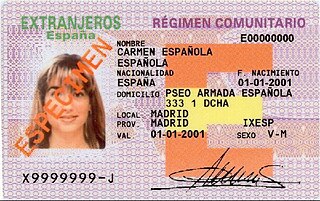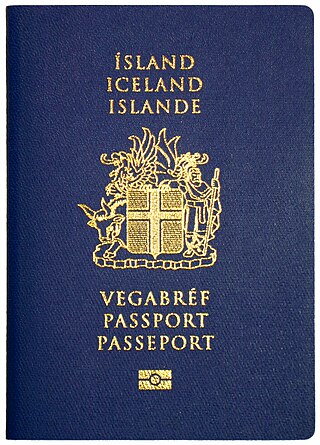
A French passport is an identity document issued to French citizens. Besides enabling the bearer to travel internationally and serving as indication of French citizenship, the passport facilitates the process of securing assistance from French consular officials abroad or other European Union member states in case a French consular is absent, if needed.

A travel document is an identity document issued by a government or international entity pursuant to international agreements to enable individuals to clear border control measures. Travel documents usually assure other governments that the bearer may return to the issuing country, and are often issued in booklet form to allow other governments to place visas as well as entry and exit stamps into them.

Croatian passport is issued to citizens of the Republic of Croatia for the purpose of international travel. The passport has the purpose of serving as proof of Croatian citizenship and identity. Responsibility for their issuance lies with the Ministry of the Interior; and for citizens abroad, passports are issued by the local embassy or consulate. Croatian passports are valid for ten or five years, and are not renewable. Every Croatian citizen is also a citizen of the European Union. The passport, along with the national identity card allows for free rights of movement and residence in any of the states of the European Economic Area and Switzerland.

European Economic Area (EEA) citizens have the right of free movement and residence throughout the EEA. This right also extends to certain family members, even if they are not EEA citizens. A Residence card of a family member of a Union citizen is issued to the family member to confirm this right of residence. The holder of a valid Residence Card is entitled to use this document in lieu of an entry visa for entry to all EEA member states. There is not a unified format for this card throughout the EU.

A Norwegian passport is the passport issued to nationals of Norway for the purpose of international travel. Beside serving as proof of Norwegian citizenship, they facilitate the process of securing assistance from Norwegian consular officials abroad.

Finnish passports are issued to nationals of Finland for the purpose of international travel. Aside from serving as proof of Finnish nationality, they facilitate the process of securing assistance from Finnish consular officials abroad.

Swedish passports are issued to nationals of Sweden for the purpose of international travel. Besides serving as proof of Swedish citizenship, they facilitate the process of securing assistance from Swedish consular officials abroad.

Egyptian passports are issued to nationals of Egypt for the purpose of international travel. Besides serving as a proof of Egyptian citizenship, they facilitate the process of securing assistance from Egyptian consular officials abroad if needed. Egyptian passports are valid for seven years for adults, and is issued for lesser periods for school or college students, or those who have not finalized their status of the military conscription. Starting in 2008, The Egyptian government introduced newer machine-readable passport (MRP), in order to comply with international passport standards and requirements with 96.7% conformance to ICAO Document 9303. The newer passports offer better security and state-of-the-art anti forging parameters and have a soft cover.

A Danish passport is an identity document issued to citizens of the Kingdom of Denmark to facilitate international travel. Besides serving as proof of Danish citizenship, they facilitate the process of securing assistance from Danish consular officials abroad.

An Austrian passport is an identity document issued to citizens of Austria to facilitate international travel. Every Austrian citizen is also a citizen of the European Union. The passport, along with the national identity card, allows for free rights of movement and residence in any of the states of the European Economic Area and Switzerland.

A Dutch passport is an identity document issued to citizens of the Kingdom of the Netherlands for the purpose of international travel. As the Netherlands only distinguish one category of citizen, for all countries in the Kingdom, passports are the same for all four countries. The passport also serves as a means of identification as required by the Dutch law since 1 January 2005 for all persons over the age of fourteen. Dutch passports are valid for a period of ten years from issuing date. The passport complies with the rules for European Union passports. Since 26 August 2006 all passports are issued as a biometric passport with an embedded contactless smartcard RFID chip for storing biometric data. Every Dutch citizen is also a citizen of the European Union. The nationality allows for free rights of movement and residence in any of the states of the European Union, European Economic Area, and Switzerland.

The European Union itself does not issue ordinary passports, but ordinary passport booklets issued by its 27 member states share a common format. This common format features a coloured cover emblazoned—in the official language(s) of the issuing country —with the title "European Union", followed by the name(s) of the member state, the heraldic "Arms" of the State concerned, the word "PASSPORT", together with the biometric passport symbol at the bottom centre of the front cover.

Icelandic passports are issued to citizens of Iceland for the purpose of international travel. Beside serving as proof of Icelandic citizenship, they facilitate the process of securing assistance from Icelandic consular officials abroad. As of 2022, 91% of Icelandic citizens possess an Icelandic passport. It is one of three official documents issued by the Icelandic government, the others being the Icelandic identity card and the Icelandic driving licence.

A United Nations laissez-passer is a diplomatic travel document issued by the United Nations under the provisions of Article VII of the 1946 Convention on the Privileges and Immunities of the United Nations in its offices in New York City and Geneva, as well as by the International Labour Organization (ILO).

The Albanian passport is a travel document issued by the Ministry of Interior to Albanian citizens to enable them to travel abroad. They are also used as proof of identity within the country, along with the Albanian ID card.

The Schengen Area is an area comprising 27 European countries that have officially abolished passports and many other types of border control at their mutual borders. Being an element within the wider area of freedom, security and justice policy of the European Union (EU), it mostly functions as a single jurisdiction under a common visa policy for international travel purposes. The area is named after the 1985 Schengen Agreement and the 1990 Schengen Convention, both signed in Schengen, Luxembourg.

The Italian electronic identity card, or simply carta d'identità, is an identification document issued to any Italian citizen and to legal aliens, that has been progressively replacing the paper-based identity card since version 3.0 was first released on 4 July 2016. The CIE is intended for both digital and physical identification. The biometric information is printed on an ID-1 card and stored in a contactless chip.

National identity cards are issued to their citizens by the governments of most European Economic Area (EEA) member states, the exceptions are Denmark and Ireland. Ireland however issues a passport card which is a valid document in the EEA and Switzerland. Denmark issues simpler identity cards that are not valid as travel documents. From 2 August 2021, new identity cards are harmonized as a common identity card model replaced the various formats already in use. There are approximately 200 million national identity cards in use in the EU/EEA, including 53 million of the new EU-standard cards. They are compulsory in 14 EU countries, voluntary in 9 countries and in 8 countries they are semi-compulsory. Where the card is compulsory, in some member countries it is required to be carried at all times, while in other countries the mere possesion of the card is sufficient.

Passports of the EFTA member states are passports issued by the European Free Trade Association (EFTA) member states Iceland, Liechtenstein, Norway and Switzerland. EFTA is in this article used as a common name for these countries.

Passports in Europe are issued by each state individually, e.g. the Netherlands or United Kingdom. In general, passports issued in Europe either grant the holder the right of freedom of movement within the European Economic Area, to those that don't. The majority of European states are members of the European Union, and therefore issue EU passports.



















